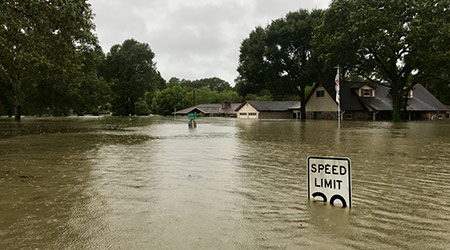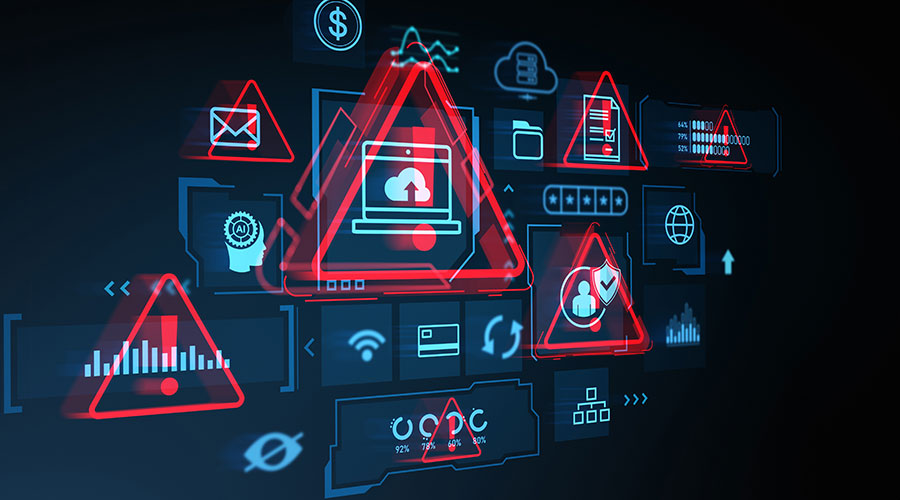Team Rubicon is an international disaster response nonprofit with a mission of using the skills and experiences of military veterans and first responders to rapidly provide relief to communities in need. Headquartered in Los Angeles, California, Team Rubicon has more than 80,000 volunteers around the country ready to jump into action when needed to provide immediate relief to those affected by natural disasters.
More than 80 percent of the disasters Team Rubicon responds to are weather-related, including crippling winter storms, catastrophic hurricanes, and severe weather outbreaks – like tornadoes. While always ready to serve, the organization needed better weather intelligence to help them prepare and mitigate risks. After adopting professional weather forecasting and monitoring tools, operations teams were able to pinpoint weather hazards, track storms, view forecasts, and set up custom alerts. And the intelligence they gained made a huge difference in the organization’s response to Hurricanes Florence and Michael.
Team Rubicon relies on skills and experiences of military veterans and first responders
About 75 percent of Team Rubicon volunteers are military veterans, who find that their skills in emergency medicine, small-unit leadership, and logistics are a great fit with disaster response. It also helps with their ability to hunker down in challenging environments to get the job done. A further 20 percent of volunteers are trained first responders, while the rest are volunteers from all walks of life. The group is a member of National Voluntary Organizations Active in Disaster (National VOAD), an association of organizations that mitigate and alleviate the impact of disasters.
By focusing on underserved or economically-challenged communities, Team Rubicon seeks to make the largest impact possible. According to William (“TJ”) Porter, manager of operational planning, Team Rubicon’s core mission is to help those who are often forgotten or left behind; they place a special emphasis on helping under-insured and uninsured populations.
Porter, a 13-year Air Force veteran, law enforcement officer, world traveler, and former American Red Cross worker, proudly stands by Team Rubicon’s service principles, “Our actions are characterized by the constant pursuit to prevent or alleviate human suffering and restore human dignity – we help people on their worst day.”
Weather-related disasters pose special challenges
The help Team Rubicon provides for weather-related disasters spans the gamut, from removing trees from roadways, clearing paths for service vehicles, bringing in supplies, conducting search and rescue missions (including boating rescues), dealing with flooded out homes, mucking out after a flood, mold remediation, and just about anything else needed. While Team Rubicon had greatly expanded its equipment inventory in recent years to help do these tasks, the organization lacked the deep level of weather intelligence that could help them understand and mitigate risks – and keep their teams safe from danger.
That’s where Baron comes into the story. After learning of the impressive work Team Rubicon is doing at the Virginia Emergency Management Conference, a Baron team member struck up a conversation with Team Rubicon, asking if they had a need for detailed and accurate weather data to help them plan their efforts. Team Rubicon jumped at the opportunity and Baron ultimately donated access to its Baron Threat Net product. Key features allow users to pinpoint weather hazards by location, track storms, view forecasts and set up custom alerts, including location-based pinpoint alerting and standard alerts from the National Weather Service (NWS). The web portal weather monitoring system provides street level views and the ability to layer numerous data products. Threat Net also offers a mobile companion application that gives Team Rubicon access to real-time weather monitoring on the go.
This suited Team Rubicon down to the ground. “In years past, we didn’t have a good way to monitor weather,” explains Porter. “We went onto the NWS, but our folks are not meteorologists, and they don’t have that background to make crucial decisions. Baron Threat Net helped us understand risks and mitigate the risks of serious events. It plays a crucial role in getting teams in as quickly as possible so we can help the greatest number of people.”
New weather tools help with response to major hurricanes
The new weather intelligence tools have already had a huge impact on Team Rubicon’s operations. Take the example of how access to weather data helped Team Rubicon with its massive response to Hurricane Florence. A day or so before the hurricane was due to make landfall, Dan Gallagher, Enterprise Product Manager and meteorologist at Baron Services, received a call from Team Rubicon, requesting product and meteorological support. Individual staff had been using the new Baron Threat Net weather tools to a degree since gaining access to them, but the operations team wanted more training and support in the face of what looked like a major disaster barreling towards North Carolina, South Carolina, Virginia, and West Virginia.
Gallagher, a trained meteorologist with more than 18 years of experience in meteorological research and software development, quickly hopped on a plane, arriving at Team Rubicon’s National Operations Center in Dallas. His first task was to meet operational manager Porter’s request to help them guide reconnaissance teams entering the area. They wanted to place a reconnaissance team close to the storm – but not in mortal danger. Using the weather tools, Gallagher located a spot north of Wilmington, NC between the hurricane’s eyewall and outer rain bands that could serve as a safe spot for reconnaissance.
The next morning, Gallagher provided a weather briefing to ensure that operations staff had the latest weather intelligence. “I briefed them on where the storm was, where it was heading, the dangers that could be anticipated, areas likely to be most affected, and the hazards in these areas.”
Throughout the day, Gallagher conducted a number of briefings and kept the teams up to date as Hurricane Florence slowly moved overland. He also provided video weather briefings for the reconnaissance team in their car en route to their destination.
Another crew based in Charlotte was planning the safest route for trucking in supplies based on weather conditions. They wanted help in choosing whether to haul the trailer from Atlanta, GA or Alexandria, VA. “I was not there to make a recommendation on an action but rather to give them the weather information they need to make their decision,” explains Gallagher. “As a meteorologist, I know what the weather is, but they decide how it impacts their operation. As soon as I gave a weather update they could make a decision within seconds, making it possible for actions based on that decision.” Team Rubicon used the information Gallagher provided to select the Alexandria VA route; their crackerjack logistics team was then able to quickly make all the needed logistical arrangements.
In addition to weather briefings, Gallagher provided more detailed product training on Baron Threat Net, observed how the teams actually use the product, and learned how the real-time products were performing. He also got great feedback on other data products that might enhance Team Rubicon’s ability to respond to disasters.
Team Rubicon gave very high marks to the high-resolution weather/forecast model available in Baron Threat Net. They relied upon the predictive precipitation accumulation and wind speed information, as well as information on total precipitation accumulation (what has already fallen in the past 24 hours).
The wind damage product showing shear rate was very useful to Team Rubicon. In addition, the product did an excellent job of detecting rotation, including picking out the weak tornadoes spawned from the hurricane that were present in the outer rain bands of Hurricane Florence. These are typically very difficult to identify and warn people about, because they spin up quickly and are relatively shallow and weak (with tornado damage of EF0 or EF1 as measured on the Enhanced Fujita Scale). Gallagher had seen how well the wind damage product performed in larger tornado cases but was particularly gratified at how well it helped the team detect these smaller ones.
For example, Lauren Vatier of Team Rubicon’s National Incident Management Team commented that she had worked with Baron Threat Net before the Florence event, but using it so intensively made her more familiar with how to use the product and really helped cement her knowledge. “Before Florence I had not used Baron Threat Net for intel purposes. Today I am looking for information on rain accumulation and wind, and I’m looking ahead to help the team understand what the situation will look like in the future. It helps me understand and verify the actual information happening with the storm. I don’t like relying on news articles. Now I can look into the product and get accurate and reliable information.”
Vatier also really likes the ability to pinpoint information on a map showing colors and ranges. “You can click on a point and tell how much accumulation has occurred or what the wind speed is. The pinpointing is a valuable part of Baron Threat Net.” The patented Baron Pinpoint Alerting technology automatically sends notifications any time impactful weather approaches; alert types include severe storms and tornadoes; proximity alerts for approaching lightning, hail, snow and rain; and National Weather Service warnings. She concludes, “I feel empowered by the program. It ups my confidence in my ability to provide accurate information.”
TJ Porter concurred that Baron Threat Net helped Team Rubicon mobilize the large teams that deployed for Hurricane Florence. “It is crucial to put people on the ground and make sure they’re safe. Baron Threat Net helps us respond quicker to disasters. It also helps the strike teams ensure they are not caught up in other secondary or rapid onset weather events.”
Porter explains that the situation unit leaders actively monitor weather through the day using Baron Threat Net. “We are giving them all the tools at our disposal, because these are the folks who provide early warnings to keep our folks safe.”
Future-proofing weather data
Being on the ground with Team Rubicon during the Hurricane Florence disaster recovery response gave Baron’s Gallagher an unusual opportunity to discuss other ways Baron weather products could help respond to weather-related disasters. According to Porter, “We are looking to Baron to help us understand secondary events, like the extensive flooding resulting from Hurricane Florence, and to understand where these hazards are today, tomorrow, and the next day.”
In addition, Team Rubicon is committed to targeting those areas of greatest need, so they want to be able to layer weather information with other data sets, especially social vulnerability, including location of areas with uninsured or underinsured populations. Says Porter, “Getting into areas we know need help will shave minutes, hours, or even days off how long it takes to be there helping”.
In the storm’s aftermath
At the time this article was written, hundreds of Team Rubicon volunteers were deployed as part of Hurricane Florence response operations and later in response to Hurricane Michael. Their work has garnered them a tremendous amount of national appreciation, including a spotlight appearance during Game 1 of the World Series. T-Mobile used its commercial television spots to support the organization, also pledging to donate $5,000 per post-season home run plus $1 per Twitter or Instagram post using #HR4HR to Team Rubicon.
Baron’s Gallagher appreciated the opportunity to see in real time how customers use its products, saying “The experience helped me frame improvements we can develop that will positively affect our clients using Baron Threat Net.”
Glen Denny is the President of Enterprise Solutions for Baron Critical Weather Solutions.

 Healthcare Facilities Look to Future-Proof Facilities
Healthcare Facilities Look to Future-Proof Facilities Yale New Haven Health Experiences Data Breach
Yale New Haven Health Experiences Data Breach Rethinking Facilities: A New-Generation Approach to Behavioral Healthcare
Rethinking Facilities: A New-Generation Approach to Behavioral Healthcare ThedaCare to Open Medical Center in Fond du Lac, Wisconsin
ThedaCare to Open Medical Center in Fond du Lac, Wisconsin UF Health Hospitals Rely on Green Globes to Realize Their Full Potential
UF Health Hospitals Rely on Green Globes to Realize Their Full Potential